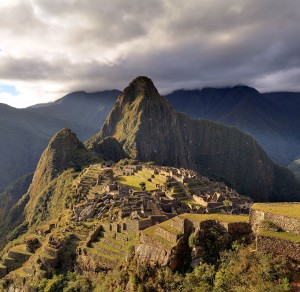Good morning, Whitewater.
Thursday in the city will be sunny with a high of seventy-five.

On this day in 1911, Hiram Bingham discovers Machu Picchu:
Machu Picchu (in hispanicized spelling, Spanish pronunciation: … or Machu Pikchu (Quechua machu old, old person, pikchu peak; mountain or prominence with a broad base which ends in sharp peaks,[1] “old peak”, pronunciation … is a 15th-century Inca site located 2,430 metres (7,970 ft) above sea level.[2][3] It is located in the Cusco Region, Urubamba Province, Machupicchu District in Peru.[4] It is situated on a mountain ridge above the Sacred Valley which is 80 kilometres (50 mi) northwest of Cusco and through which the Urubamba Riverflows. Most archaeologists believe that Machu Picchu was built as an estate for the Inca emperor Pachacuti (1438–1472). Often mistakenly referred to as the “Lost City of the Incas”, it is perhaps the most familiar icon of Inca civilization.
The Incas built the estate around 1450, but abandoned it a century later at the time of the Spanish Conquest. Although known locally, it was unknown to the outside world before being brought to international attention in 1911 by the American historian Hiram Bingham. Since then, Machu Picchu has become an important tourist attraction. Most of the outlying buildings have been reconstructed in order to give tourists a better idea of what the structures originally looked like.[5] By 1976, thirty percent of Machu Picchu had been restored.[5] The restoration work continues to this day.[6]
Since the site was not known to the Spanish during their conquest, it is highly significant as a relatively intact cultural site. Machu Picchu was declared a Peruvian Historical Sanctuary in 1981 and a UNESCO World Heritage Site in 1983.[3] In 2007, Machu Picchu was voted one of the New Seven Wonders of the World in a worldwide Internet poll.
On this day in 1892, fire levels most of a Wisconsin town:
1892 – Fire Destroys Iron River
On this date a major fire destroyed most of Iron River, Wisconsin. After the fire was extinguished, the town resembled a “tent city” during the rebuilding. [Source: “B” Book I, Beer Bottles, Brawls, Boards, Brothels, Bibles, Battles & Brownstone by Tony Woiak, p.18]
Google-a-Day presents a question about the Second World War:
What was the name of the Allied operation against which German forces launched a counteroffensive in Anzio in 1944?
